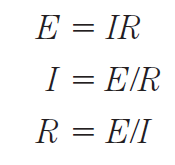


 الفيزياء الكلاسيكية
الفيزياء الكلاسيكية
 الكهربائية والمغناطيسية
الكهربائية والمغناطيسية
 علم البصريات
علم البصريات
 الفيزياء الحديثة
الفيزياء الحديثة
 النظرية النسبية
النظرية النسبية
 الفيزياء النووية
الفيزياء النووية
 فيزياء الحالة الصلبة
فيزياء الحالة الصلبة
 الليزر
الليزر
 علم الفلك
علم الفلك
 المجموعة الشمسية
المجموعة الشمسية
 الطاقة البديلة
الطاقة البديلة
 الفيزياء والعلوم الأخرى
الفيزياء والعلوم الأخرى
 مواضيع عامة في الفيزياء
مواضيع عامة في الفيزياء|
Read More
Date: 4-5-2021
Date: 11-5-2021
Date: 23-4-2021
|
Ohm’s Law
The interdependence between current, voltage, and resistance is one of the most fundamental rules, or laws, in electrical circuits. It is called Ohm’s Law, named after the scientist who supposedly first expressed it. Three formulas denote this law:

You need only to remember the first one in order to derive the others. The easiest way to remember it is to learn the abbreviations E for EMF or voltage, I for current and R for resistance, and then remember that they appear in alphabetical order with the equals sign after the E.
Sometimes the three symbols are written in a triangle, as in Fig. 1. To find the value of one, you cover it up and read the positions of the others.

Fig. 1: Ohm’s Law triangle.
It’s important to remember that you must use units of volts, amperes, and ohms in order for Ohm’s Law to work right. If you use volts, milliamperes, and ohms or kilovolts, microamperes, and megohms you cannot expect to get the right answers. If the initial quantities are given in units other than volts, amperes, and ohms, you must convert to these units, then calculate. After that, you can convert the units back again to whatever you like. For example, if you get 13,500,000 ohms as a calculated resistance, you might prefer to say that it’s 13.5 megohms.



|
|
|
|
"عادة ليلية" قد تكون المفتاح للوقاية من الخرف
|
|
|
|
|
|
|
ممتص الصدمات: طريقة عمله وأهميته وأبرز علامات تلفه
|
|
|
|
|
|
|
المجمع العلمي للقرآن الكريم يقيم جلسة حوارية لطلبة جامعة الكوفة
|
|
|